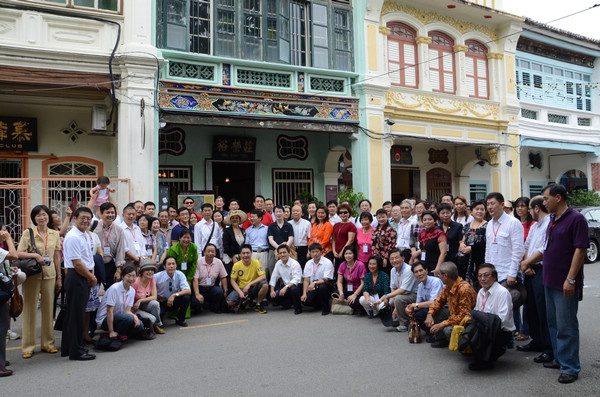Tracking the root of revolution
 0 Comment(s)
0 Comment(s) Print
Print E-mail
China Daily, October 10, 2011
E-mail
China Daily, October 10, 2011
The house at 120 Armenian Street could easily be mistaken for just another quaint, rather pretty 19th century dwelling in Penang's George Town heritage zone. It lacks the breathtaking grandeur of the Khoo Kongsi (clan house) or the pomp of the Pinang Peranakan Mansion. But what it lacks in physical splendor, it more than makes up for in historical importance.
 |
|
Members of the Sun Yat-sen Penang Base outside 120 Armenian Street. |
This is where Sun Yat-sen launched fund-raising campaigns for the Second Guangzhou Uprising (also known as the Huanghuagang Uprising) and for the Southeast Asian headquarters of the Tongmenghui, his underground resistance movement.
This historic venue is now known as the Sun Yat-sen Penang Base.
Sun's Penang connection is, however, not that well known despite the island hosting two pivotal moments in the Chinese revolution. Sun planned a meeting with his supporters for the Huanghuagang Uprising at 404 Dato' Kramat Road, which was Sun's residence then. The event became known as the Penang Conference.
The following day, Sun started his fund-raising campaign at 120 Armenian Street.
Through a moving speech, he beseeched his close supporters to "help shoulder the responsibility of saving our country by donating your money while our comrades in our country are sacrificing their lives"
Sun raised $8,000 (Straits dollars) immediately. Both events helped the uprising, which tragically failed. But historians believe it triggered the Wuchang Uprising and then the Xinhai Revolution.
Perhaps of equal significance are the four dark and desperate months between July and December 1910 that Sun spent in Penang.
"Sun arrived in Penang a despondent man. With the failure of the eighth uprising, he had lost resources and people. His family was bankrupt. His supporters on the island had been financially stretched by the revolution. Letters to supporters around the world asking for more funds were met with months of silence. Revolutionary fervor appeared to be waning," explained Goh Mai Loon, representative of the Sun Yat-sen Penang Base. "In letters, he recounted that these were among the most difficult times he had faced in his entire life. The whole world, he felt, had abandoned him."
It was during this time that the people of Penang rallied around Sun and helped him regroup. In Sun Yat-sen in Penang, Khoo Salma Nasution, the custodian of the base, writes, "When Sun's family was living in Penang, they could not even afford to pay their monthly house rent of $20. The Penang supporters discussed Sun's situation and undertook to provide his family with $120 or $130 each month for their living expenses While in Penang, Sun received news of his mother's death. As the Sun family was broke at the time, the Penang supporters collected donations for the funeral expenses."
Penang sacrificed too for the China of Sun's dreams. Of the 72 martyrs in the failed Huanghuagang Uprising, four men came from, or had connections to, Penang Luo Zhonghuo, Zhou Hua, Chen Wenbao and Li Yannan.
Others, like Goh Say Eng (Wu Shirong), the founding chairman of the Penang Tongmenghui, gave generously from personal fortunes. Having supported Sun from their first meeting in 1906, the tycoon gradually sold off his family properties to finance the revolution and died a pauper in 1941. Another stalwart and founding vice-chairman of the Penang Tongmenghui, Ng Kim Kheng (Huang Jingqing), also gave away his fortune for the cause.






Go to Forum >>0 Comment(s)